by Sam Rietmann
What do Mary Poppins and the Terminator have in common? Not much if we are honest. Yet I encountered both of these figures
in the studio of Kitty Dorje as we sat down to chat about the importance of silence, her new series of work and what the future holds.
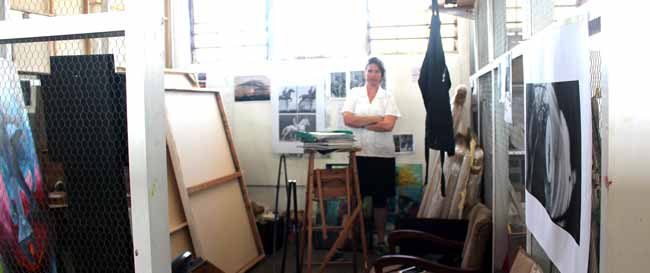
SR: You emerged from UCT with a distinctive style and created the Remerge series. How is Kitty ‘the artist now’
different from the Kitty ‘the recent graduate’?
KD: Well firstly when I created Remerge, I was pretty angry (I had just broken up with my boyfriend) and that gives you a lot
of audacity. It was a black and white series and that was because of UCT’s influence. They emphasized having to write
everything down and conceptualizing a work in full before you do anything, which doesn’t work for me at all. I found my work
was reduced to black and white. I did print making at UCT but I found myself quite frustrated in that none of my technical
knowledge, I am a graphic designer by trade, was accessed during my time there. But now having left UCT and being in my
current studio I’ve allowed myself to come into colour and really enjoy it. It’s kinda like a playful state returning to colour and
different techniques.
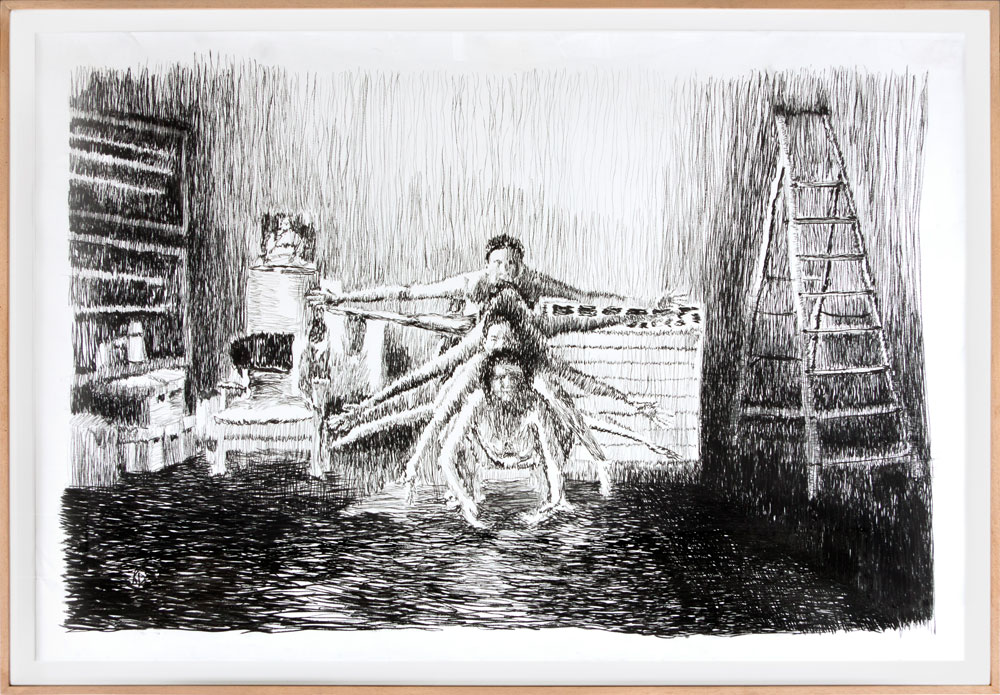
Remerge: Flight Composite
SR: And what do you find this new playfulness has led you too?
KD: I have begun a series called the Mary Poppins series. It’s a series of works using digital prints on existing Fabriano paper.
I understand the importance of good quality artistic tools, like good quality paper, and craftsmanship but I also understand that
tools like technology can be accessed and used as well. They should not be ostracised or ‘othered’ in any way. This series
combines digital prints and etching and shows how they can both live in harmony together. There is nothing wrong with digital
meets craft. I mean it is an incredibly empowered position.
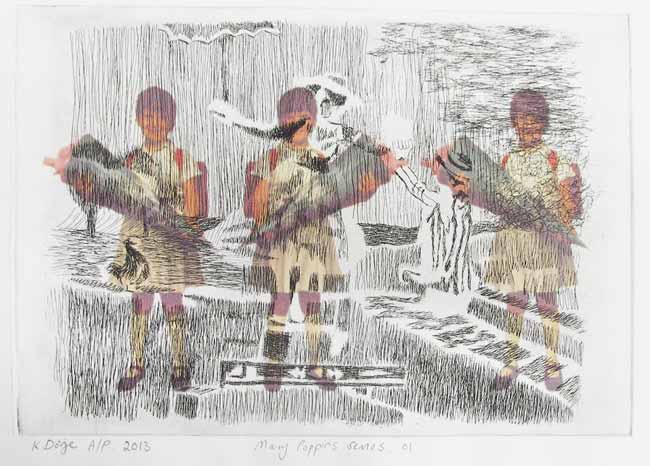
Mary Poppins Series I: A/P
SR: What was the inspiration behind this series?
KD: I started this body of work in a previous studio where I was running a drawing class. I found that every time I had to prepare
for a class I would spend two days having to clean the space and only one day teaching, that was frustrating. However, what I
got from that was ‘Mary Poppins’ and the importance of being Mary Poppins- Being that person who clears the space,
being that person who is of service. In many ways that is viewed as bi- feminist perhaps by some generations, as possibly being
disempowered. I think often there is this misconception that when you work in service that you are lesser in some way. However
being in service is important and will be viewed by future generations as such. Mary Poppins is a teacher and I am going to go
into teaching as well. I have just done a post graduate certificate at UCT.
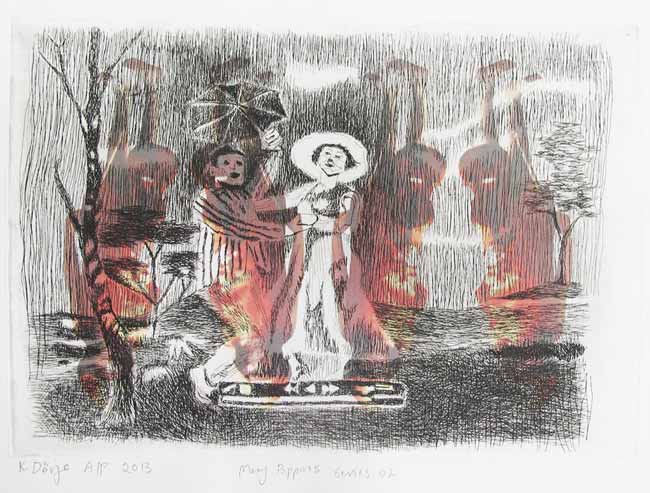
Mary Poppins Series II: A/P
SR: The digital images in this series are mainly of you and your sister, how does that tie in with the Mary Poppins
etchings?
KD: It’s kinda about Mary Poppins meets my childhood. I have this white, middle class, South African, privileged childhood
that happened during apartheid. In many ways I had the classic childhood. Going through the whole of Rustenburg and then
afterwards deciding to be graphic designer. Now I find myself reflecting on my childhood, looking at this privileged background
and then looking at my current state where I am sometimes denied access to certain tools based on my colour and B.E.E
legislation. The question I am posing is: is it okay having come from a privileged background, really having liked Mary Poppins,
to express that and not be judged in the current political context? All I would like to do is express these memories- that’s just what
these are.
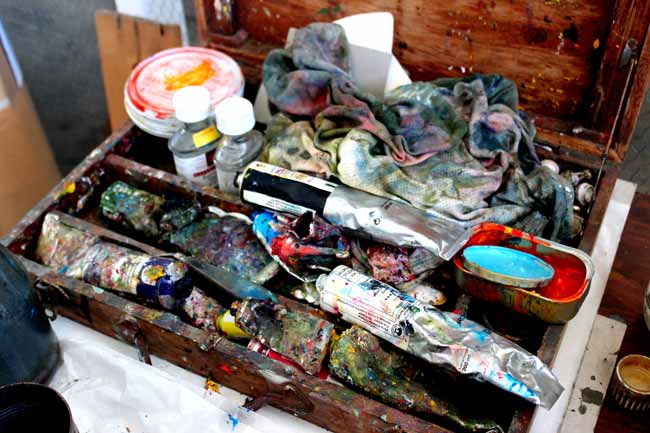
SR: You talked about how your privileged background has influenced you artistic career and your works. How has
your position as a woman affected your work?
KD: I have found myself very privileged to be a woman. And to be in a South African context of gay rights as well. There is a
strong understanding that people who are disempowered need to be given a voice but not be mollycoddled. So there is a
space allowed for the strength of the voice to show through.

SR: Earlier you mentioned that you had just finished your teaching diploma, which means that you would have
experienced some prac. teaching. How has that been?
KD: Sometimes you find that schools are not very open to arts because it doesn’t correspond with their discipline
systems. If you just let kids express themselves completely freely, it’s very counter to any school discipline code so
it becomes difficult to know where to draw the line. That ‘line’ is something I have had to deal with a lot this year.
Some schools like Milnerton High were great. There were a lot of craftsmen, kids who were willing to do work and
I really loved that. There were so many young kids that, if they were given the right opportunities, could make this
country into an amazing space. Just to see that was very inspirational.

SR: If you had to give these kids one bit of advice that was given to you, what would it be?
KD: It doesn’t matter how much money you have, what matters is skill and that will see you through. You can have the
simplest thing, something like wood, and you could create something that is worth more than gold, worth more than
a Mercedes Benz, more than any conventional understanding of affluence.

SR: Apart from teaching and your Mary Poppins series, you are also working on a series entitled ‘Wounds of Colour’,
tell us more.
KD: This is for a show that is going to happen in Joburg. Again it’s about incorporating technology into old media so neither
becomes obsolete in any way- so there is a fusion. This image is a painted video still from Terminator. Essentially what I
am doing here is painstakingly recreating something that I could do in seconds with my digital knowledge. Yet I still persist
with painting. Why? Because I think that there is something to be said for not doing things too fast. Painting is a slow
meaningful process and which allows me to engage with the painting from day to day. If I had just printed it out in two
seconds, I could be in China and mass produce twenty million copies of meaningless shite.
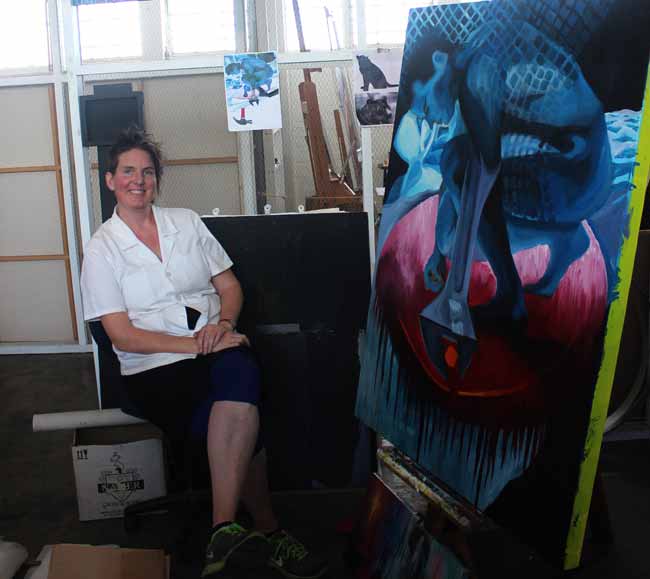
SR: Why Terminator?
KD: Well I was feeling a bit like I was a terminator. My last series of work went into Nazism and embracing of the ‘other’ in
the new South Africa. So if I were to go to a Jewish person in the new South African community and say I want to embody
Nazism, would they be able to accept my ‘other’? Do they have to accept me or can they ‘take me out’, like a Terminator
and vice versa? In a democracy there need to be two points of view and a conversation. Disagreement in democracy means
that we have to ‘agree to disagree’ and not tell that person they have to leave just because they disagree with you. It’s about
discussion. It’s not ‘taking out’ people out physically but it is ‘taking out’ prejudice verbally.
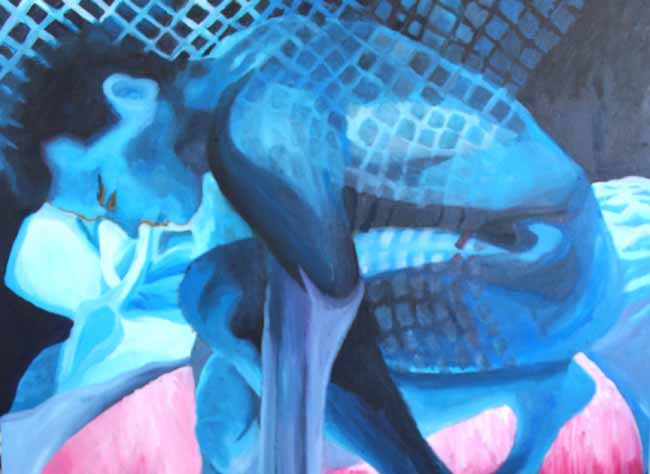
SR: So you have two different series on the go as well as studying- with so much going on how do you stay focused?
KD: I have been finding moments of silence are really good. Just moments when not everything has to be expressed and that
allows for interesting things to come up, but it depends on my mood. At the moment I have been downloading this trance track
which is a bit frantic and repetitive but I am also learning to work in silence. Sometimes music is a nice way to escape though.
If I don’t want to be there then I listen to music. You put your head phones on and then you are alone. It’s a way of creating a
barrier. I also really like ambient music that just allows for breathing space and you can imagine that you are in the jungle
or somewhere far way. However, sometimes the frenetic stuff helps with work pace. Music is a tool and it depends
how you are feeling, if you need to be energised or to just relax.

SR: And what do you do to relax?
KD: Walking on the mountain, I like to walk, watch videos and read. I have been going through a bit of a reclusive mode at the
moment. Recently my life has been really quite suburban, balancing working in the studio and going to university or into the
schools for teaching pracs., I am a bit of a workaholic at the moment. I am trying to get myself organised and then I will be
more relaxed. At the moment though my main relaxation has been walking and going out and meeting with friends.
View Kitty's Portfolio

